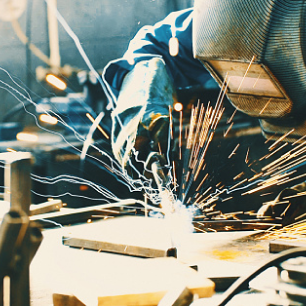Jump to:
Achieving Quality Welding
Quality welding is the bedrock of welding execution. Quality means satisfying a customer’s requirements in terms of performance, appearance, and intended purpose. Businesses in well-regulated industries, such as aerospace and nuclear, understand that quality is not inspected into a weldment — Fig. 1. Strict engineering procedures exist where weld failure is not an option without placing undue risks on human life, the environment, and property. Substandard quality and unreliable welds cost lives (e.g., the gas pipeline explosion in San Bruno, Calif., 2010). In addition, substandard quality results in waste due to nonvalue-added expenses, such as lost revenue due to rework or repairs, liability lawsuits, warranty repairs, replacements and delay costs, liquidated damages, and penalties. Poor quality also has an adverse business marketing effect, such as lost opportunities due to a tarnished reputation for quality and customer dissatisfaction. Quality welding is a crucial component within global society in fabricating safe, reliable, and trustworthy weldments.
Quality Management System (QMS)
Various quality assurance (QA) systems are used in welding companies. For example, a QMS such as ISO 9001:2015, Quality management systems – requirements, is highly esteemed. A QMS exercises proactive and predictive methods compared to a reactive, corrective, after-the-fact approach. From the QMS standpoint, the most effective way to attain weld and weldment quality is to avoid having defects in the first place. Also, it is less costly to prevent defects than to correct them after they have occurred. Within ISO 9001:2015, welding is considered a special process because its quality cannot be readily verified. Consequently, a great deal of emphasis is placed on process controls to prevent the occurrence of weld defects.
A QMS, ASME and AWS weld codes, and the ISO 3834, Quality requirements for fusion welding of metallic materials, standard complement one another. A QMS outlines quality system criteria, and weld codes and ISO 3834 detail the requirements for procedure qualification records (PQRs), welding procedure specifications (WPSs), and welder qualifications.
Within a QMS, training and personnel qualification are key. Case in point, welder performance qualifications (WPQs) are conducted to confirm a welder’s ability to deposit sound weld metal using a specific process, material, and weld position. Poor quality and unreliable welds are produced without requisite abilities and process knowledge, creating undue safety risks — Figs. 2, 3, and 7. To continuously improve weld and weldment quality, employ a well-executed QMS.
Continuous Improvements
Process controls within a QMS are the method by which quality is manufactured into a weld and weldment (e.g., weld process control and monitoring systems, mechanized technologies, statistical techniques, and qualified WPSs).
A fundamental aspect of a QMS is continuous improvements. Improving the production process via proactive and predictive methods can be done as follows:
Using a QMS drives proactivity, such as exercising design for welding (DFW) and design for manufactur-ability/design for assembly (DFM/DFA) concepts:
- A. Confirming weldability, weld joint design, and weld joint accessibility;
- B. Performing weld joint mock-up testing;
- C. Minimizing the number of weld joints by forming or stamping parts; and
- D. Performing in-process inspections throughout production. The objective is to catch and correct discrepancies, such as visual weld discontinuities or defects, early into production (Figs. 3 and 4), thereby mitigating rework and repair costs and lost production time and improving the weld and weldment quality and the production process.
Utilizing predictive methods, such as collecting welding inspection, welding parameters, and weld-bead geometry data, during welding to develop artificial intelligence (AI)-based algorithms to predict the weld parameters necessary to attain the optimal weld bead geometry and weld quality.
Human Performance Attributes
The following are pivotal human performance attributes that contribute to accomplishing quality welding. Ultimately, for a company, the core values, viewpoints, and prevailing paradigms are such that craftsmanship represents a culture, a behavior, and a way of thinking.
1. Attitude
Taking pride in performance (i.e., pride of workmanship).
Being self-motivated to provide solutions to tasks.
2. Accountability
Taking ownership of work and performance.
Producing and delivering a superior product because the quality of workmanship is a reflection of the welder, fitter, inspector, and supervisor.
3. Workmanship
Employing skill and proficiency with which a task is performed — focusing upon the task and applying garnered training and lessons learned from experience.
Having zero tolerance for rework and repairs due to poor work practices, shortcuts, or cutting corners.
4. Teamwork
Collaborating with and supporting others to improve first-time quality production performance.
Encouraging an environment of inclusion and constructive brainstorming to improve the overall work plan.
5. Knowledge and training
Seeking opportunities to train and mentor others in areas of your expertise.
Seeking self-development through continuous education and training to become an expert.
6. Professionalism and integrity
Being honest, trustworthy, and doing what is right in the absence of oversight.
Wanting to do top-of-the-line work the right way the first time — Fig. 5.
Training Makes a Difference
There is no substitution for knowledge and having a well-trained workforce. Expert training is vital to improving individual competencies in occupational skills, subject knowledge, and work practices to attain quality welding. A quote from Henry Ford echoes this philosophy: “The only thing worse than training your employees and then having them leave is not training them and having them stay.”
Figures 2, 3, 4, and 7 illustrate the adverse consequences of not having personnel possessing the required occupational skills and knowledge to facilitate the prevention of errors, quality issues, nonvalue-added expenses, and undue safety risks, which, if uncorrected, could seriously affect safety and operability. To produce quality welds, welders require training to achieve requisite proficiencies and process knowledge.
To produce accurate work, fitters require fitup, layouts, and shop mathematics training. The AWS Certified Weld-ing Inspector (CWI) program and the Hobart Institute of Welding Technology offer CWI training and certification for weld inspection. Online CWI preparatory studies are also available through various training schools and businesses. For nondestructive examination (NDE), the American Society of Nondestructive Testing (ASNT) offers online and classroom classes for continuing education and preparation courses for their certification programs. NDE training is also available via an array of training schools and businesses. The American Society for Quality (ASQ) offers quality engineering training and certification. The AWS Certified Welding Supervisor (CWS) program provides training and certification for welding supervision. A fundamental principle is that training pertains to everyone engaged in activities that affect quality. Train as you work and work as you train.
Achieving Quality Welding
Pertinent methods to achieve quality welding are as follows:
1. Training
For example, qualifying welders (WPQ) per code criteria with the required skills and process knowledge, such as understanding weld filler metals, WPSs, and welding symbols.
2. Weldability
Confirming weldability. Employing DFW and DFM/DFA concepts (e.g., minimizing the number of weld joints). Ensuring weld joint accessibility to the welder. Designing dissimilar metal weld joints with compatible physical, chemical, and metallurgical properties. Performing weld joint mock-up testing.
3. Qualifying PQRs and WPSs
Documenting variables, weld joint geometry, weld bead sequence, and test results during PQR qualification. Accurately writing WPSs with correct variable ranges, including abundant process details. It is crucial that welders receive a copy of WPSs for production.
4. Tooling
Using welding positioners to perform welding in the 1G, 2G, or 1F, 2F position. Employing fixturing and tooling to attain weld joint fit-up accuracy and repeatability.
5. PokA-Yoke
Applying Poka-Yoke (mistake-proofing) practices during production.
6. Fit-ups
Ensuring proper weld joint preparation, fitup, and alignment.
7. Materials
Utilizing certified materials with certified material test reports (CMTRs).
8. QMS
Using a QMS as the foundation in the application of pertinent methods to achieve quality welding.
9. Processes
Utilizing the optimum welding process, such as mechanized, orbital, cobotic, robotic, and solid-state technologies.
10. Internal Audits
Ensuring code books, NDE manuals and procedures, WPSs, and WPQs are up-to-date.
11. Process Controls
Using weld process control and monitoring systems, performing statistical techniques, and providing workmanship criteria (e.g., written standards, representative samples, and illustrations).
12. Calibration
Calibrating welding, testing, and metrology equipment and inspection tools on an annual basis. Adopting a preventive maintenance (PM) program.
13. Personnel
Recruiting and retaining qualified personnel.
14. Inspections
Performing in-process welding inspections throughout production to ensure strict technical compliance to codes, WPSs, and drawings. Also, verifying process and quality performance and collecting process data.
15. Leadership
Making certain principal personnel are available on the shop floor and on the jobsite to provide direction and problem-solving expertise and support.
The House of Quality Welding
The House of Quality Welding is likened to a house of cards, where each structural member contributes to achieving quality welding — Fig. 6. The objective is to uphold the house’s structural integrity by not compromising weld quality. The house is constructed upon the foundation of quality welding: a QMS, such as ISO 9001:2015. Within a culture of a quality environment, a QMS serves as the house’s foundation, where the pillars of fundamental welding knowledge and workmanship quality principles arise. Compared to other quality systems, the House of Quality Welding is predicated upon a well-executed QMS that is robust, proactive, and vigilant in continuously improving production effectiveness and efficiency by means of preventing, correcting, and eliminating opportunities for errors, deficiencies, and nonconformances that transpire throughout production. As noted previously, the most effective way to attain weld and weldment quality is to avoid having defects in the first place. Inscribed on the house’s walls are examples of quality welding and fabrication tenets.
What Does Quality Mean to You?
Consider the welds in Figs. 1 and 7. The welds are at the opposite ends of the quality spectrum. Figure 1 shows welds pertaining to an ASME Section III power plant project. Figure 7 shows welds that are of poor quality, unreliable, and pose undue safety risks. The point is that all welds require some level of quality to adequately serve their intended purpose. For example, in Fig. 7, if the weld of the fence frame fails and the frame collapses, there would be a real problem. To improve weld and weldment quality, you must improve the fabrication and welding processes that produce the quality. Thus, if you want a quality weld and weldment, they must be manufactured with quality processes, quality materials, and by quality-minded people; quality must be manufactured into the weld and weldment. Achieving a corporate-wide commitment to quality takes time, resources, and a determined effort — and it begins in the boardroom.
Conclusion
A strong quality welding reputation is a decisive differentiator when vetting businesses to perform consequential fabrication and welding work. A well-executed QMS, in-process inspections, human performance attributes, and training contribute to achieving quality welding.
WILLIAM C. LAPLANTE (wlaplante.scwi@gmail.com) is a welding engineer as well as an AWS CWI, SCWI, and CWE in Manchester, N.H.


